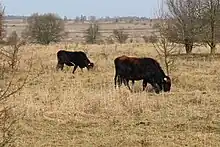| Milovice Nature Reserve | |
|---|---|
IUCN category IV (habitat/species management area) | |
 Rewilding effort - Exmoor ponies | |
 Map of Czech Republic | |
| Location | Milovice, Czech Republic |
| Nearest town | Benátky nad Jizerou, Milovice |
| Coordinates | 50°14′13″N 14°53′8″E / 50.23694°N 14.88556°E |
| Area | 350 ha (860 acres) |
| Established | 2015 |
| Operator | Česká krajina o.p.s. |
| www | |
Milovice Nature Reserve (Czech: Přírodní rezervace Milovice) is a nature reserve next to the towns of Milovice and Benátky nad Jizerou in Nymburk District, Central Bohemian Region, Czech Republic. Established in 2015,[1] the area is administered by the Česká krajina o.p.s. organization, as a part of Evropsky významná lokalita Milovice-Mladá CZ0214006[2] protected area, part of the European Union project Natura 2000.[3] This reserve is a pioneering project of cooperation between several scientific bodies (Czech Academy of Sciences, University of South Bohemia České Budějovice, Charles University Prague, Czech University of Life Sciences Prague, Masaryk University Brno among others) and draws support from many organizations and private sponsors (EU's Operational Programme Environment - Obnova stanovišť a zavedení pastvy velkých spásačů, Central Bohemian Region, EKOSPOL, Net4Gas, Pivovar Zubr, Nadační fond rodiny Orlických, JK Jewels, State Environmental Fund of the Czech Republic, Milovice and Benátky nad Jizerou townships, American International School of Vienna, Milovice kindergarten, Townshend International School in Hluboká nad Vltavou and more).[4]
History
A no longer used military proving ground near Milovice has been left fallow, after departure of heavy machinery the former open landscape started to be overtaken by bushgrass and other expansive species and its biodiversity kept diminishing. Rare species of birds and insects dependent on special ecosystem maintained by military activity started disappearing, until conservation grazing has been suggested as a method of maintaining the rare ecosystem. While overgrowth management using sheep grazing and scything is being used in some protected areas in the Czech Republic, sheep still graze differently from wild animals and their grazing is selective. Česká krajina came up with a unique proposition - reintroducing three species of large herbivorous mammals.
The project started by fencing in the area and creating an acclimatization pen, then on January 28, 2015, a group of 14 Exmoor ponies were moved from Exmoor National Park to Milovice in an effort to save the biodiversity of the location through conservation grazing.[5]
The first herd of six Tauros cattle, bought from Dutch Taurus Foundation, arrived in October 2015.[6]
The first herd of European bison has been bought from European Bison Friends Society in Poland in November 2014.[7] The group of seven female bisons from three Polish reserves (Pszczyna, Niepołomice and Kiermusy) arrived to Milovice in December 2015.[8]
A second herd of 14 Exmoor mares joined the bison enclosure in December 2015.[9]
In January 2018, nine young Exmoor stallions left Milovice on loan to two more protected areas, four are at Na Plachtě (cz) in Hradec Králové and five at Josefov Meadows bird reserve.[10] The stallions, born in Milovice in 2016, left their herds in accordance with natural behavior. Young stallions are at around two years of age chased away from their herd by its stallion, they form male groups where they grow stronger and better their skills, so that one day the strongest can fight a local stallion for his herd of mares.
In February 2018, two Tauros heifers left the Milovice herd on loan to Živá voda exposition in Modrá (Uherské Hradiště District).[11]
Rewilding
Large herbivorous mammals (bison, aurochs, Eurasian wild horse, elk) used to be an indispensable part of European wildlife. Aurochs and tarpan have been driven to extinction and bison only survived in captivity. Exmoor ponies and Tauros cattle are used as an ecological substitute for the wild horse and aurochs.
European bison

European bison, also called wisent, has been brought to Milovice from Poland on December 6, 2015. These seven particular Bison bonasus females belong to the rarer lowland (Białowieża) line. The bison has good prospects of reintroduction into the wild in the Czech Republic.[12] As the first step, the herd in Milovice is held in a large enclosure. In January 2016 four-year-old bull Polanin III arrived from Ośrodek Kultury Leśnej in Gołuchow (pl).[13] The first calf was born in May 2016. The international bison studbook has assigned a "TU" prefix to the names of all bisons born in Milovice.
- Numbers in total: 21 European bisons - 8 already born in Milovice (June 2018)[14]
Tauros cattle

Since the original aurochs (Bos primigenius) went extinct in 1627, Česká krajina picked breeding back cattle from the Dutch Tauros Programme. Tauros cattle are a crossbreed of several breeds of cattle with the aim to create a breed resembling aurochs.[15] The first herd of Tauros cattle arrived to the Czech Republic in October 2015, one male and five females. The first calf was born in April 2016.
- Numbers in total: 13 Tauros cattle - 7 born in Milovice (February 2018)[16]
Horses

The very first herd of 14 Exmoor ponies (all mares) arrived to the Czech Republic in January 2015, in April the herd was joined by seven-year-old Exmoor stallion Northcroft Firestarter. The first wild horse foal born in the Czech Republic came on October 22, 2015, therefore her mother, Sgurr Na Ban A’Mhoire, must have come to Milovice already pregnant. The first Firestarter offspring arrived in March 2016. A second herd of Exmoors in the adjoining enclosure includes a second breeding stallion from UK, Tawbitts Mystic Merlin, born 2008.
- Numbers in total: 55 Exmoor ponies - 25 already born in Milovice (February 2018)[17]
Biodiversity
European jackal has been scientifically observed in Milovice since 2015, the first photographic evidence of jackal breeding came in 2017.[18] It is the northernmost documented location in Europe where jackal successfully breeds.
First systematic monitoring of bats in Milovice discovered at least 18 different bat species, making it a two thirds of the total number of bat species native to the Czech Republic.[19] Higher night-time bat activity was spotted above the large herbivore enclosures, showing the beneficial influence of conservation grazing on insect population. The bats also benefit from numerous ponds providing them with water and from the dense mosaic of deciduous forests, meadows and steppes. Among the counted species is the rare lesser horseshoe bat, lesser noctule and Bechstein's bat.
A 2016 monitoring of butterflies found 59 species making it 42% of all butterfly species living in the Czech Republic.[20] Eight protected and five endangered species were observed, for example phengaris rebeli, large copper, brown argus, plebejus argyrognomon, silver-washed fritillary, Amanda's blue, silver-studded blue, Meleager's blue, green forester and pearly heath.
A European grey wolf was spotted by a trail cam inside the bison enclosure, so far it seems the animal had just been passing through.[21]
See also
- Tourism in the Czech Republic
- Protected areas of the Czech Republic
- Rewilding (conservation biology)
- Conservation grazing
- Oostvaardersplassen, a similar large herbivores rewilding project in the Netherlands
- Western Caucasus, the largest bison (wisent) habitat
External links
- Kudyznudy Czech Tourism
- Přírodní rezervace Milovice
- Truppenübungsplatz Milowitz gallery of park photos by Michal Köpping
References
- ↑ http://www.obec-lipnik.cz/e_download.php?file=data/uredni_deska/obsah331_7.pdf&original=sp%C3%A1sa%C4%8Di.pdf
- ↑ "EVL Milovice - Mladá". Ústřední seznam ochrany přírody. Nature Conservation Agency of the Czech Republic (AOPK ČR). Retrieved 2017-04-03.
- ↑ "CZ0214006 - Milovice - Mladá". Evropsky významné lokality v České republice. Nature Conservation Agency of the Czech Republic (AOPK ČR). Retrieved 2017-04-03.
- ↑ "Přírodní rezervace Milovice".
- ↑ "Czechs import wild horses to save biodiversity". CBS News. 23 March 2015. Retrieved 3 April 2017.
- ↑ "První stádo praturů ve střední a východní Evropě se zabydluje v Milovicích". Česká krajina. 13 October 2015. Retrieved 3 April 2017.
- ↑ "Česká krajina koupila první stádo zubrů pro Českou republiku". 10 January 2014. Retrieved 3 April 2017.
- ↑ "Do Česka míří největší transport zubrů v historii, cílem je bývalý vojenský prostor Milovice". 27 November 2015. Retrieved 3 April 2017.
- ↑ "Druhé stádo divokých koní přijelo do rezervace, doplnilo skupinu zubrů". 17 December 2015. Retrieved 3 April 2017.
- ↑ "Divocí koně z Milovic se už zabydlují ve dvou lokalitách na východě Čech". 20 January 2018. Retrieved 23 February 2018.
- ↑ "Mladí pratuři z Milovic odjeli k Velehradu, v obci Modrá budou součástí expozice Živá voda". 13 February 2018. Retrieved 23 February 2018.
- ↑ Dostál, Dalibor; Jirků, Miloslav; Konvička, Martin; Čížek, Lukáš; Šálek, Martin (November 2012). Návrat zubra evropského (Bison bonasus) do České republiky (PDF). Česká krajina o.p.s. Retrieved 3 April 2017.
- ↑ "Polanin wzbogacił czeskie stado polskich żubrów". Stowarzyszenie Miłośników Żubrów. 14 January 2016. Retrieved 3 April 2017.
- ↑ "Počet zubrů v rezervaci překročil dvacet kusů, narodila se další dvě mláďata". Česká krajina. 15 June 2018. Retrieved 18 June 2018.
- ↑ "Pratur se připravuje na návrat do českých hor a lesů". Česká krajina. 27 September 2012. Retrieved 3 April 2017.
- ↑ "Fotogalerie: Praturů eviduje společnost Česká krajina již 15 kusů, z toho devět mláďat (Z".
- ↑ "Fotogalerie: Aktuální stav divokých koní činí 64 kusů, z toho je 34 hříbat, která už se".
- ↑ "Ve středních Čechách odchovávají šakali mladé. Usadili se tu trvale". iDnes.cz. 17 July 2017. Retrieved 23 February 2018.
- ↑ "Nečekaný ráj netopýrů. V bývalém vojenském prostoru u Milovic vědci napočítali dvě třetiny českých druhů". Česká krajina. 6 December 2017. Retrieved 23 February 2018.
- ↑ "Díky divokým koním lítá na malé pastvině u Milovic 59 druhů motýlů". iDnes.cz. 16 March 2017. Retrieved 25 February 2018.
- ↑ "V rezervaci u zubrů a divokých koní se objevil VLK. Zachytila ho fotopast | Česká krajina %". 24 April 2018.
